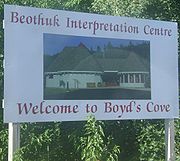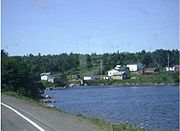
Boyd's Cove, Newfoundland and Labrador
Encyclopedia


Lewisporte, Newfoundland and Labrador
Lewisporte is a town in central Newfoundland Island, Canada, with a population of 3,312. It is situated in a bay close to the mouth of the Exploits River. Lewisporte has an excellent port and related facilities that serve the many communities along Notre Dame Bay. Gander and its international...
in Newfoundland
Newfoundland and Labrador
Newfoundland and Labrador is the easternmost province of Canada. Situated in the country's Atlantic region, it incorporates the island of Newfoundland and mainland Labrador with a combined area of . As of April 2011, the province's estimated population is 508,400...
, Canada
Canada
Canada is a North American country consisting of ten provinces and three territories. Located in the northern part of the continent, it extends from the Atlantic Ocean in the east to the Pacific Ocean in the west, and northward into the Arctic Ocean...
.
Boyd's Cove was first settled by the Beothuks in the late 18th century and later re-established by the Newman family from Fogo Island in the late 19th century. At first it was a logging and fishing community, but later became one of the main sources of turnip, carrot, potato and hay in the Nortre Dame Bay area.
A major Beothuk
Beothuk
The Beothuk were one of the aboriginal peoples in Canada. They lived on the island of Newfoundland at the time of European contact in the 15th and 16th centuries...
archaeological site at Boyd's Cove was excavated by Dr. Ralph T. Pastore
Ralph T. Pastore
Ralph T. Pastore, historian and archaeologist, late of Memorial University of Newfoundland, St. John's NFLD, discovered the Boyd's Cove Beothuk settlement.Pastore was a native of Balston Spa, New York, and was educated at the University of Notre Dame...
of Memorial University of Newfoundland
Memorial University of Newfoundland
Memorial University of Newfoundland, is a comprehensive university located primarily in St...
. in the early 1980s. The site is now home to the Boyd's Cove Interpretation Centre. Archaeological evidence revealed that Boyd's Cove has been occupied intermittently for about 2000 years. BEOTHUK pit houses dating from the late 17th or the early 18th century have yielded stone tools lying nearby European artifacts. These tools helped to establish a link between the Beothuk and their prehistoric ancestors. Faunal analysis indicated that the site was occupied at least from late winter to fall, and that the Beothuk relied on both marine and land resources for their subsistence.
“Shanawdithit
Shanawdithit
Shanawdithit , also noted as Shawnadithititis, Shawnawdithit, Nancy April and Nancy Shanawdithit, was the last known living member of the Beothuk people of Newfoundland, Canada. Also remembered for drawings she made towards the end of her life, Shawnawdithit was in her late twenties when she died...
”, is the name of the last known Beothuk
Beothuk
The Beothuk were one of the aboriginal peoples in Canada. They lived on the island of Newfoundland at the time of European contact in the 15th and 16th centuries...
to have lived. She died in St. John's Newfoundland in 1829, and since her death, scientists and the public at large have been baffled by the reasons of the most unfortunate extinction of these people. In the late 1970s, archaeologists such as Raymond LeBlanc, James Tuck , and historians such as Frederick Rowe, and Leslie Upton, had arrived at the conclusion that “the Beothuk extinction was not the result of a genocidal campaign by white settlers, but rather the result of European disease and starvation--the latter resulting from an expanding European settler population that denied the Beothuks access to the vital resources of the sea.” Several other writers had also mentioned the fact that the Beothuks appear to have generally avoided most contact with the Europeans, and Upton also noted that there was virtually no fur trade between European traders and the Beothuks. This was atypical, for elsewhere in the region and throughout North America, Native peoples sought out Europeans to trade furs for blankets, kettles, knives, hatchets, and other various tools.
Present day Boyd's Cove currently has one convenience store; a team of ambulances; a recreation centre doubling as a fire hall; an engine repair shop; and a hairdresser. As younger families move away to find work, most of the town's residents are now seniors. The population is estimated to be 250, with no more than 40 children attending school.
Boyd's Cove started as a fishing settlement, with most residents coming from Fogo Island and Change Islands and settling here on the mainland of the Island of Newfoundland. The settlers were hard workers and very dedicated people. It was often a struggle. With the nearest hospital being in Lewisporte, NL, nearly 1½ hours away by horse in the 1920s and 1930s, illnesses were rarely overcome. If there was a serious illness, such as Tuberculosis (TB), then residents would have to go to St. John's.

